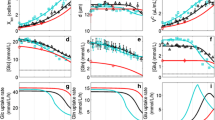Abstract
A model mouse hybridoma cell line was grown in continuous culture experiments in a serum-free low-protein lipid-free medium. The steady-state responses of cell numbers, extra- and intracellular metabolite concentrations, substrate and (by) product consumption/production rates, and yield coefficients were investigated as a function of step changes in the glutamine concentration of the feed medium. In addition to the commonly performed analysis of metabolites in culture supernatants, we prepared perchloric acid extracts of cells and determined the amount and the composition of intracellular amino acids and organic acids. Significant differences were found with respect to intracellular metabolite pools for cells growing at nearly identical specific growth rates. To our knowledge this is the first time that data on the intracellular concentrations (pools) of amino acids and Krebs cycle intermediates are reported in the literature that were obtained under carefully defined culture conditions such as those attained in continuous culture experiments.
Similar content being viewed by others
References
Clark RM, Chandler PT, Park CS and Norman AW (1980) Extracellular amino acid effects on milk protein synthesis and intracellular amino acid pools with bovine mammary cells in culture. J. Dairy Sci. 63: 1230–1234.
Darmaun D, Matthews DE, Desjeux J-F and Bier DM (1988) Glutamine and glutamate nitrogen exchangeable pools in cultured fibroblasts: a stable isotope study. J. Cell. Physiol. 134: 143–148.
Eagle H, Piez KA and Levy M (1961) The intracellular amino acid concentrations required for protein synthesis in cultured human cells. J. Biol. Chem. 236: 2039–2042.
Eigenbrodt E, Fister P and Reinacher M (1985) New perspectives on carbohydrate metabolism in tumor cells. In: Beitner R (ed.) Regulation of Carbohydrate Metabolism, Vol. II (pp. 141–179) CRC Press Inc., Boca Raton.
Fernandez EJ, Mancuso A and Clark DS (1988) NMR spectroscopy studies of hybridoma metabolism in a simple membrane reactor. Biotechnol. Prog. 4: 173–183.
Fernandez EJ, Mancuso A, Murphy MK, Blanch HW and Clark DS (1990) Nuclear magnetic resonance methods for observating the intracellular environment of mammalian cells. Ann. N.Y. Acad. Sci. 589: 458–475.
Melancon SB, Tayco J and Nadler BL (1972) The free amino acid pool of cultivated human skin fibroblasts. Proc. Soc. Exp. Biol. Med. 141: 391–395.
Oxender DL, Lee M and Cecchini G (1977) Regulation of amino acid transport activity and growth rate of animal cells in culture. J. Biol. Chem. 252: 2680–2683.
Petronini PG, Tramacere M, Mazzini A, Kay JE and Borghetti AF (1989) Control of protein synthesis by extracellular Na+ in cultured fibroblasts. J. Cell. Physiol. 140: 202–211.
Reitzer LJ, Wice BM and Kennell D (1979) Evidence that glutamine, not sugar, is the major energy source for cultured HeLa cells. J. Biol. Chem. 254: 2669–2676.
Renner ED, Plagemann PGW and Benlohr RW (1972) Pemeation of glucose by simple and facilitated diffusion by Novikoff rat hepatoma cells in suspension culture and its relationship to glucose metabolism. J. Biol. Chem. 247: 5765–5776.
Silvotti L, Petronini PG, Mazzini A, Piedimonte G and Borghetti AF (1991) Differential adaptive response to hypersmolarity of 3T3 and transformed SV3T3 cells. Exp. Cell Res. 193: 253–261.
Schmid G and Blanch HW (1992) Extra- and intracellular metabolite concentrations for murine hydridoma cells. Appl. Microbiol. Biotechnol. 36: 621–625.
Schmid G, Wilke CR and Blanch HW (1992) Continuous hybridoma suspension cultures with and without cell retention: kinetics of growth, metabolism and product formation. J. Biotechnol. 22: 31–40.
Weigang F, Reiter M, Jungbauer A and Katinger H (1989) High-performance liquid chromatographic determination of metabolic products for fermentation control of mammalian cell culture: analysis of carbohydrates, organic acids and orthophosphate using refractive index and ultraviolet detectors. J. Chrom. 497: 59–68.
Author information
Authors and Affiliations
Rights and permissions
About this article
Cite this article
Schmid, G., Keller, T. Monitoring hybridoma metabolism in continuous suspension culture at the intracellular level. Cytotechnology 9, 217–229 (1992). https://doi.org/10.1007/BF02521749
Received:
Accepted:
Issue Date:
DOI: https://doi.org/10.1007/BF02521749




